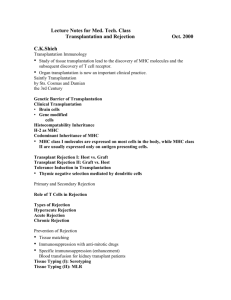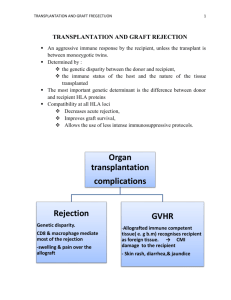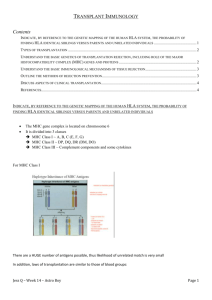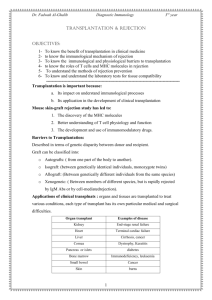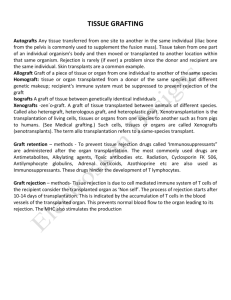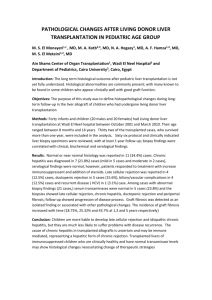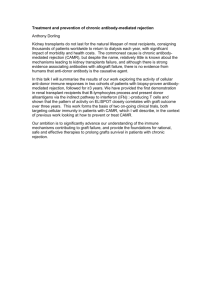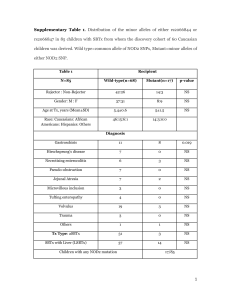Transplantation and Rejection
advertisement
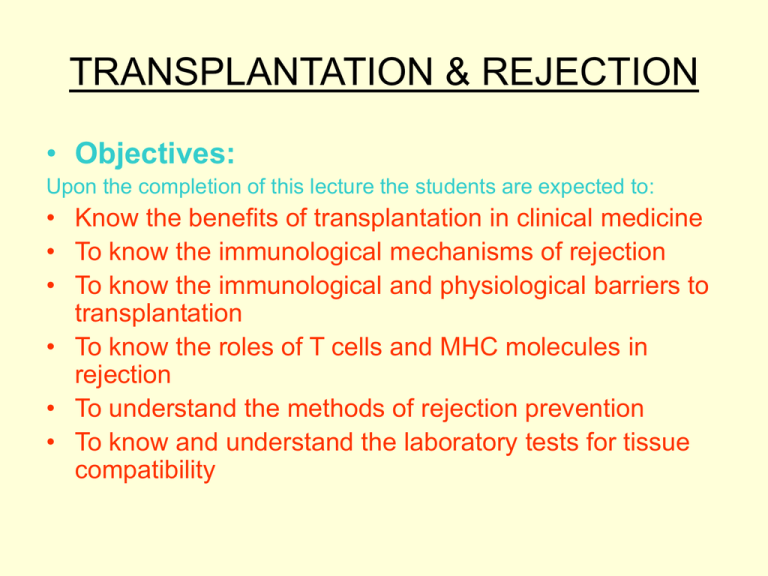
TRANSPLANTATION & REJECTION • Objectives: Upon the completion of this lecture the students are expected to: • Know the benefits of transplantation in clinical medicine • To know the immunological mechanisms of rejection • To know the immunological and physiological barriers to transplantation • To know the roles of T cells and MHC molecules in rejection • To understand the methods of rejection prevention • To know and understand the laboratory tests for tissue compatibility Transplantation and Rejection • Studying the immunology of transplantation and rejection is important because: • Its impact on understanding of immunological practice • Its applications in the development of clinical transplantation IT has led to: Discovery of MHC molecules Better understanding of T cell physiology and function Development and use of immunomodulatory drugs Applications Organ transplanted Kidney Heart Liver Cornea Pancreas or Islets Bone marrow Small bowel Skin Example of disease End stage renal failure Terminal cardiac failure Cirrhosis, Cancer Dystrophy Diabetes Immunodeficiency, Leukemia Cancer Burns Barriers to transplantation: Genetic differences between the donor and recipient: Graft can be classified into: • Autografts: From one part of the body to another • Isografts: Between isogenic individuals • Allografts: Between genetically different individuals from the same species ( Most common) • Xenografts: Between members of different species ( rapidly rejected by IgM or cell mediated rejection) Histocompatibility antigens • Genes that are responsible for rejection • There are more than 30 gene loci • Reject at different rate • In human known as human leucocyte antigens (HLA) • Cellular constituents are called minor histocompatibility antigens • These induce rejection at a slower rate • Combination of several minor antigens induce strong rejection • MHC haplotypes are inherited from both parents and are co dominantly expressed • MHC are expressed in transplanted tissues and are induced by cytokines (INFγ and TNF) • In transplantation foreign MHC molecules can directly activate T cells • This is unique to transplantation !! • Host-versus-graft responses cause transplant rejection • Graft-versus-host reactions result when donor lymphocytes attack the graft recipient The role of lymphocyte in rejection • In experimental animals: – Removal of thymus leads to inability to reject transplant – Irradiation to remove existing T cells leads to inability to reject transplant – Ability to restore rejection can be achieved by injecting T cells from animal of the same strain • This gives strong evidence that T cells are crucial in the rejection process. • Ab cause graft damage and macrophages are involved in inflammation Presentation of Graft antigen • 1- High density of graft MHC molecules react weakly with TCR and generate signal for T cell activation • 2- Graft MHC molecules can present the graft’s own peptides including peptides from both major /minor MHC molecules • 3- Graft MHC can present processed antigen of host molecules causing lack of host tolerance • 4- Host antigen presenting cells can uptake different graft molecules and process and present these antigens Rate of rejection: The rate of rejection depends on the type underlying effector mechanisms: Type of rejection Time taken cause Hyperacute Min-hours Anti-donor Ab and complement Accelerated Days Reactivation of T cells Acute Days- weeks Primary activation of T cells Chronic MonthsYears Unclear Immunological components of rejection PREVINTION OF REJECTION • Non specific immunosupression can reduce rejection reaction; • Large dose of X ray • Steroid : have anti-inflammatory activity and suppress macrophages • Cyclosporin: suppress lymphokines production • Azatioprine :blocks Tc proliferation Laboratory testing for Histocompatibility : 1-Tissue typing by using flow cytometry to identify human leukocyte antigens (HLA) 2- Serological tissue typing 3-Tissue typing-mixed lymphocyte reaction Serologic tissue typing: Principle: • Performed by adding typing antisera of defined specificity ( e.g. anti-HLA-BB) • Complement and trypan blue stain are added to the test • The trypan stain will stain dead cells with blue color • This indicates that the tested cells carry the antigen Tissue typing-mixed lymphocyte reaction (MLR) Principle: • The cells being tested are incubated with “typing cells” of known specificity • The tested cells will recognize the typing cells as foreign cells and proliferate • If the tested cells are carrying the same specificity as the typing cells they will not proliferate
